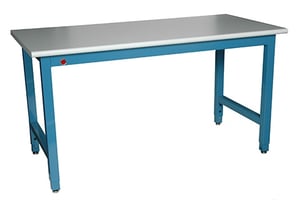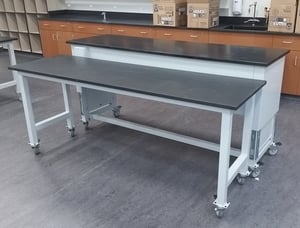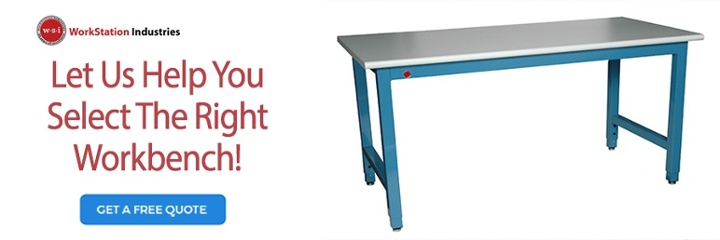Many components go into the construction of an industrial workbench. From shelving, drawers and work surfaces, to foot rests, lighting and utility enhancements. All play an important role in the efficiency of that piece of furniture and your overall workspace.
One component of an industrial workbench often gets overlooked, however. Legs play an integral part of any table or piece of furniture, but in an industrial setting, legs can mean the difference between average, everyday use and heavy duty use.
Here are some reasons why you shouldn’t overlook the legs you choose for your industrial workbench.
Legs Impact Durability And Strength
The construction of your workbench directly impacts its durability and strength. If you want your workbench to  be able to withstand heavy duty, extra heavy duty or standard use, the workbench’s legs must correlate.
be able to withstand heavy duty, extra heavy duty or standard use, the workbench’s legs must correlate.
Heavy duty benches are usually constructed with 14 gauge steel, all welded with 2” square legs for long-lasting durability and strength. When a lower shelf or horizontal bar is added, this gives it greater structural stability.
Extra heavy duty benches are usually constructed with 12 gauge steel, all welded with 3” square legs for extra durability and strength. A lower shelf gives the bench added structural stability, and an extra heavy duty bench typically comes with pre-punched floor mounting plates on the legs for additional stability.
Standard benches are typically constructed from 16 gauge steel. They are fully welded and have 2” square legs. They may have a lower shelf or foot rest bar, but usually come with floor leveling glides or optional casters.
Weight Load Capacity Is Impacted
A workbench’s legs play a critical role in how much weight it can support. As pointed out above, the type of steel and size of legs impact the workbench’s durability and strength.
Heavy duty benches will typically have a 5,000 lb. weight load capacity. If the workbench is 96” wide, the weight load capacity will usually go down to 4,000 lbs.
Extra heavy duty workbenches will support the greatest amount of weight, between 10,000 and 20,000 lbs.
Standard workbenches will usually only support between 750 and 1,000 lbs.
Why does this matter? If the scope of your manufacturing space involves heavy materials and equipment, a heavier duty workbench will provide more durability and therefore be a safer investment.
Hydraulic Capabilities Promote Better Health
Sitting or standing in one place is often part of the job for workers in the manufacturing industry. 
Research shows companies that embrace ergonomics in an effort to reduce discomfort and injuries save more money over time. In fact, OSHA reports that for every $3 spent on worker’s compensation claims, $1 of that results from a lack of ergonomic protection.
One way to incorporate ergonomically-friendly solutions is through an adjustable workbench. Ergonomically adjustable hydraulic benches essentially shorten or elongate the legs of a bench so that an employee can sit or stand at a comfortable and supportive level.
By making it more comfortable to work, ergonomic benches can reduce lost time, hours and worker’s compensation claims. Employees can choose to position the workbench at a level that suits their needs simply by using a manual, hand crank or an electric control.
Attachments Increase Comfort
Components attached to workbench legs can also increase comfort and support stability of the workbench.
A footrest tube, for example, is a simple steel bar that is mounted between the legs on opposite sides of the bench.
A footrest pan is made of steel tubing and includes a steel pan that can be tilted up or down for an operator’s comfort. The pans often include non-slip friction tape.
A freestanding footrest still connects to the leg, but has independent adjustments for the foot pan height and angle. This type of footrest is more acceptable for clean room applications.
Casters Make Workbenches Mobile
It’s important to not overlook what is at the end of workbench legs, casters. Casters allow workbenches to  become mobile.
become mobile.
Casters typically have a specific amount of weight they can carry. For example, when using all four casters, the casters may carry a load rating of 1,000 pounds.
Casters typically come in a variety of sizes, from as small as 1.25” to as large as 4”. They will lock so no movement is permitted, though may be able to swivel whether they are locked or not.
Even Legs Can Be Customized
Choosing the right industrial workbench can be difficult. Never mind choosing among the individual components that are necessary to meet your needs.
While there are a lot of choices on the market from a variety of industrial workbench manufacturers, choosing a company that includes personalized service as a top priority is important in order to ensure the highest level of safety for your employees and the highest level of efficiency for your operations.
Even a single component or part of a workbench can be customized to ensure you are meeting all regulations required of your industry and creating the best possible workspace for your workers.
Our article, Why Personalization Matters In An Industrial Furniture Company, further explores how to get additional help with figuring out your exact needs and how the best industrial furniture companies can bring your ideas to life.


